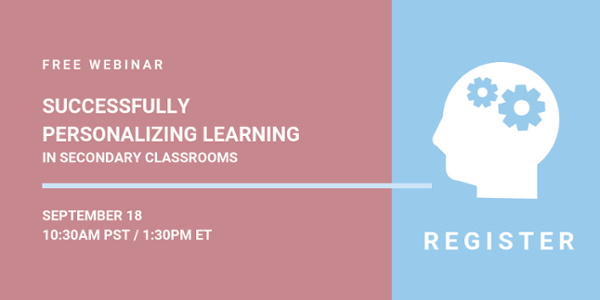Last year, a group of educators sat down with engineers from a well-known technology company. The first question the educators asked was what the engineers look for in potential candidates. Adaptability was their immediate response. The way these engineers code today is different than how they coded ten years ago and will be different ten years from now. Discrete knowledge isn’t important because it will soon be outdated. The ability to learn and grow in an ever-changing world is what defines the very best candidates.
Secondary schools are rarely designed to prepare students for these types of jobs.
There have been growing calls to redesign secondary education in the United States, and many of those calls include personalizing learning for students. Yet most district and school leaders engaged in this work often share how challenging this is in secondary schools. Personalizing learning in secondary schools requires a different approach.
The Problem: Responding to the unique challenges faced by secondary schools
The challenges associated with personalizing learning in secondary schools are often the result of well-meaning motivations, externally imposed factors, and self-imposed complications.
Mindset: Secondary teachers are likely to see themselves as content experts. “They deeply care about their content and want to share that knowledge to spark a similar love in their students,” says Megan Campion, an Associate Partner at Education Elements. While an admirable motivation, it also suggests a teacher-centered mindset. Knowledge and learning are held and shared by the teacher, versus a student-centered approach that would have students be the drivers of their own learning.
Logistics: Personalizing learning for 22 elementary students in a self-contained room versus 180 students a teacher sees for 55 minutes a day presents very different logistical challenges. Physical space, planning time, and school schedules require a different set of considerations for secondary teachers. Effectively addressing those considerations requires tactics that can be easily scaled.
High-stakes: State exams, graduation requirements, and post-secondary applications make change feel less safe. The perceived consequences of “getting it wrong” can seem like an unacceptable risk. The call to personalize learning is not about “trying something new.” It is about directly addressing the individual learning needs and interests of every student, the efforts of which will directly and positively impact these high-stakes factors.
Change: Common instructional models used to personalize learning, such as a station rotation, requires secondary teachers to make multiple changes even to begin testing them out. An elementary teacher, who has used centers their entire career, only has to change how they assign and move students between those centers. A secondary teacher has to do that, plus determine the purpose; design; and planning of each station/center. Successfully personalizing learning in secondary classrooms requires teachers to make one change at a time, and build upon each change to scale its impact.
Deeper Dive: Check out our Comprehensive Personalized Learning Guide to learn more about why PL, how to get started, content and tools, communicating initiatives, how to measure success - and more!
The Message: A greater focus on the “why”
Leaders who want teachers to personalize learning for students must communicate why this is important and tailor their messaging to different audiences. The more invested teachers are in why they are personalizing learning, the more successful they will be in making that shift. The following message examples have resonated with different groups of secondary teachers:
Students do the heavy intellectual lifting. Personalizing learning is a shift from the traditional teacher-centered lesson to one that is student-centered. That means that students should always do the heavy intellectual lifting. The teacher who relies too much on lecture is the one doing the most work. Students learn the most when they are the ones doing the practice, discussion, and thinking.
Employers prioritize soft skills. Because so much about the world is changing, employers care less about discrete knowledge than they do about the soft skills that allow an employee to adapt to the changing times. Leadership, communication, and collaboration are the top three skills companies are developing in their employees. More than half of students in a national survey by AdvancED reported that “their school did a poor or very poor job of preparing them for employment.” Classes that personalize learning model the adaptability that employers are looking for and are better positioned to engage students in the work that develops leadership, communication, and collaboration.
The world is becoming more personalized. Big data is allowing companies to personalize our everyday experience, from targeted ads on Facebook to suggested shows on Netflix. Our Chief Operating Officer, Amy Jenkins, shared how even her spin class is becoming more personalized for its riders. People are coming to expect a more personalized experience, and students and families are no exception. Those schools that can best adapt to these changing expectations will be the best positioned to prepare its students for the future.
Teacher-centered lessons only work for some students. Some teachers argue that what they’ve done forever has worked. Is this true for all students, or just some? Is it true for students with IEPs, or whose first language is not English, or who are coming into class significantly behind or ahead of their peers? Traditional teacher-centered lessons often work well for teachers, but do they meet the individual needs and interests of all students?
The Shifts: Meeting secondary teachers where they are
Personalizing learning is not about a model; it is about meeting the needs and interests of every student. Schools that want to help secondary teachers do this should consider the following:
Start by asking secondary teachers to make one change at a time. The American Psychological Association suggests that people only “change one behavior at a time” when trying to make a lifestyle change. Shifting one’s instructional approach is the professional version of a lifestyle change. It can quickly become overwhelming if you try and do too much. Teachers should focus on making one manageable change at a time. Those early wins will inspire teachers to build on the early changes. Keeping it small also helps teachers better manage the logistical consideration required in these types of changes.
Use the most common instructional practices to personalize students’ learning. Pablo Picasso once said, “Learn the rules like a pro so that you can break them like an artist.” The “rules” teachers are best positioned to break are the instructional practices they use the most. How can homework be differentiated to meet the unique needs of every student? Could a post-quiz reflection help students build more ownership in their learning? How might teachers use exit ticket data to target small groups of students the next day?
Build from the “I do, We do, You do” model. If there is one “universal” instructional model in secondary classrooms, it is the “I do, We do, You do” model. Many educators’ training introduced this as a rigid format, but why must every lesson follow this exact sequence? Couldn’t students collaboratively explore a topic before getting direct instruction? Why can’t a lesson include several “we do” activities in the same period? Could teachers design learning pathways that allow different groups of students to simultaneously engage in different kinds of “I do,” “We do,” and “You do” work? And most importantly, how can teachers limit the amount of time they spend in the “I do” portion of class and increase the time students spend working collaboratively and independently? The more flexibility teachers see in lesson components, the more opportunities arise to personalize learning for students.
To learn more about successfully personalizing learning in secondary classrooms, join our free webinar!





